286 scholarly books by Haus Publishing and 34
have author last names that start with C
286 scholarly books by Haus Publishing and 34
286 scholarly books by Haus Publishing
34 have author last names that start with C have author last names that start with C
34 have author last names that start with C have author last names that start with C
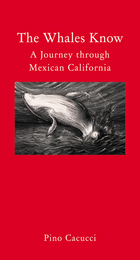
The Whales Know
A Journey through Mexican California
Pino Cacucci
Haus Publishing, 2014
Following in the footsteps of John Steinbeck, Cacucci travels through endless expanses of desert, salt mountains and rows of cacti with thorns so sharp that they can impale thirsty birds... Written with humour and heart, this is an insight into an ecosystem under threat and he describes the landscape and its inhabitants with compassion and respect.
[more]
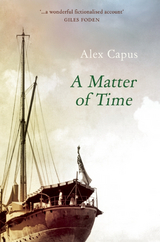
A Matter of Time
Alex Capus
Haus Publishing, 2009
A little known backwater of the history of the Great War is vividly rendered by a great story-teller - the central characters and events of this book are based on fact, but their surroundings and experiences are richly drawn from the author's imagination and detailed research.
[more]

Life is Good
Alex Capus
Haus Publishing, 2018
Max has been married to Tina for twenty-five years. She is the love of his life, but now he must come to terms with the fact that she is to spend a year away on a work assignment—away, for the first time, from their home, their children and their life together. Her absence leaves him feeling like an Odysseus in reverse: he stays put whilehis Penelope goes out into the world.
Max, alone with his three teenage sons for the first time, is left contemplating life and the daily routine of the little bar of which he is the proprietor. As he spends more time with the regulars their problems begin to become his own. This new novel by Alex Capus is a hymn to trust, friendship and life’s small pleasures. Told with his trademark humor, Life is Good is a novel about finding contentment in rootedness as the world speeds up.
Max, alone with his three teenage sons for the first time, is left contemplating life and the daily routine of the little bar of which he is the proprietor. As he spends more time with the regulars their problems begin to become his own. This new novel by Alex Capus is a hymn to trust, friendship and life’s small pleasures. Told with his trademark humor, Life is Good is a novel about finding contentment in rootedness as the world speeds up.
[more]
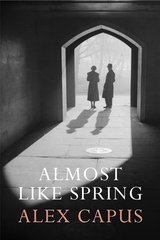
Almost Like Spring
Alex Capus
Haus Publishing, 2014
With brilliantly vivid irony, a mosaic of voices tells the true story of Switzerland's most notorious bank robbers: Kurt Sandweg and Waldemar Velte. As 1933 draws to a close, the pair arrive in Basel from Wuppertal, Germany. Rebels on the run, they are searching for an escape from the confines of a callously regimented society left impoverished by the Depression and the onset of Nazi power. However, their desperation leads them to a realm outside reality, on a destructive path of vengeance for the world's abhorrent lack of justice. Resolute on their doomed mission, neither expected to fall in love. Seen through the benign eyes of Dorly Schupp, the agonising humanity of their relationships are sharply juxtaposed against the reckless cruelty of their crimes. Yet in a world equally heartless and unremitting, who should shoulder the blame? Capus relates the portrait of these chillingly charismatic figures in a curious blend of documentary and narrative where precision of detail collides with an economy of emotion, and leaves the desolation of their situation stark and blindingly poignant. Suspended between the tragic and comic, Capus's novel mimics the absurd idiosyncrasies of life where often nothing but interpretation is left to determine the sacred from the profane.
[more]

Leon and Louise
Alex Capus
Haus Publishing, 2011
Summer 1918. The First World War is drawing to a close when Léon Le Gall, a French teenager from Cherbourg who has dropped out of school and left home, falls in love with Louise Janvier. Both are severely wounded by German artillery fire, are separated, and believe each other to be dead. Briefly reunited two decades later, the two lovers are torn apart again by Louise's refusal to destroy Léon's marriage and by the German invasion of France. In occupied Paris during the Second World War, where Léon struggles against the abhorrent tasks imposed upon him by the SS, and the wilds of Africa, where Louise confronts the hardships of her primitive environment, they battle the vicissitudes of history and the passage of time for the survival of their love.
[more]

A Price to Pay
Alex Capus
Haus Publishing, 2014
Alex Capus’s novels have been runaway best-sellers in Germany, and his novel Léon and Louise received widespread critical acclaim on its English publication in 2012.
A Price to Pay, the fourth of Capus’s novels to be published in English, tells the interwoven stories of three disparate figures from interwar Switzerland: pacifist Felix Bloch, who ends up working on the Manhattan Project; Laura d’Oriano, who wants to become a singer but instead becomes an Allied spy in fascist Italy; and Emile Gillieron, who accompanies Heinrich Schliemann to Troy and becomes one of art’s greatest forgers. Taking off from the only moment in history when all three were in the same place—a November day in 1924 at Zürich Station—Capus traces their diverging paths as they secure their places in the annals of history—but at what price?
A Price to Pay, the fourth of Capus’s novels to be published in English, tells the interwoven stories of three disparate figures from interwar Switzerland: pacifist Felix Bloch, who ends up working on the Manhattan Project; Laura d’Oriano, who wants to become a singer but instead becomes an Allied spy in fascist Italy; and Emile Gillieron, who accompanies Heinrich Schliemann to Troy and becomes one of art’s greatest forgers. Taking off from the only moment in history when all three were in the same place—a November day in 1924 at Zürich Station—Capus traces their diverging paths as they secure their places in the annals of history—but at what price?
[more]

Sailing by Starlight
In Search of Treasure Island
Alex Capus
Haus Publishing, 2011
Capus takes us on an exploratory journey via the loss of a Spanish vessel laden with gold and jewels in the South Seas, the burial of treasure, an ancient map, and a long and dangerous voyage across the Pacific, to prove that Robert Louis Stevenson's "treasure island" actually exists; and that it exists in a place quite different from where hordes of treasure-hunters have been seeking it for generations. In fact, he posits, it was for this reason alone that Stevenson spent the last five years of his life in Samoa. On a long trip round the Pacific islands with the idea of writing articles for American periodicals, Stevenson, travelling with his beloved wife, Fanny, and stepson Lloyd Osbourne, had no notion of stopping at Samoa when their ship made landfall in December 1889. Yet, only six weeks later, at the age of 39, he would invest all his available assets in a patch of impenetrable jungle and spend the rest of his life there. This book traces what led Stevenson to Samoa and the origins of his famous story. For facing him from this unlikely spot was another island – a conical isle, Tafahi, where legends abound, and it was, Capus suggests, this isle that would cause him to change the course of his life.
[more]

Skidoo
A Journey through the Ghost Towns of the American West
Alex Capus
Haus Publishing, 2013
Decades after westward expansion swept over it, settled it, and domesticated it, the Wild West remains a potent source of American myth and mystery. But the actual history, and the traces of it that remain, are at least as interesting as the fiction, and in Skidoo, writer and novelist Alex Capus takes us on a fascinating tour of the skeleton of the American West—the ghost towns and collapsing mines that lie far from interstates and airports, lost in history.
Walking in the footsteps of bank robbers and grave diggers, desperadoes and Native Americans, beer brewers and child brides, Capus uncovers story after story of adventure, violence, and exploration. Near Salt Wells, Nevada, he learns the story of a luckless inventor whose corpse was discovered frozen in the desert, an icicle hanging from its nose. In Skidoo, California, he tells us of a brawling bartender, Hootch Simpson, who was hanged twice—once by a mob, once by the law—before being beheaded during his autopsy. And in Flagstaff, Arizona, Capus traces the long-lost origins of Route 66, as a narrow, isolated trail for Edward Fitzgerald Beale’s Camel Corps.
Packed with period detail, and told with a verve and enthusiasm to rival Pecos Bill, the stories in Skidoo are sure to enchant any lover of Western tales or America’s wild history.
Walking in the footsteps of bank robbers and grave diggers, desperadoes and Native Americans, beer brewers and child brides, Capus uncovers story after story of adventure, violence, and exploration. Near Salt Wells, Nevada, he learns the story of a luckless inventor whose corpse was discovered frozen in the desert, an icicle hanging from its nose. In Skidoo, California, he tells us of a brawling bartender, Hootch Simpson, who was hanged twice—once by a mob, once by the law—before being beheaded during his autopsy. And in Flagstaff, Arizona, Capus traces the long-lost origins of Route 66, as a narrow, isolated trail for Edward Fitzgerald Beale’s Camel Corps.
Packed with period detail, and told with a verve and enthusiasm to rival Pecos Bill, the stories in Skidoo are sure to enchant any lover of Western tales or America’s wild history.
[more]
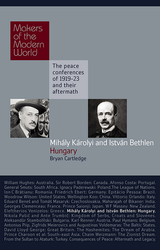
Karolyi & Bethlen
Hungary
Bryan Cartledge
Haus Publishing, 2009
White aster flowers, on sale on the streets of Budapest on the eve of All Souls' Day, are made the symbol of a revolution which brings Mihály Károlyi (1875-1955) to power at the head of a National Council. Károlyi concludes an armistice which leaves large areas of Hungarian territory under occupation by French, Romanian and Serbian forces. Following the King-Emperor's abdication in November 1918, Hungary is declared an independent republic with Károlyi as its President. He sets about meeting Hungary's most pressing social need, for land reform. But Károlyi's liberal regime is soon beset by strong opposition from the right and from the left. The Allies seal Károlyi's fate by refusing to end the economic blockade of Hungary and by imposing, even in advance of a peace settlement (Hungary is denied an invitation until the Conference is virtually over), even harsher armistice terms. Károlyi flinches from opposing these measures by force. The small socialist element in his government of well-meaning aristocrats defects and forms an alliance with Hungary's fledgling Communist Party. Károlyi resigns and chooses exile. The Communists, led by Bela Kun, take power. Kun raises a Red Army, which defeats a Czech invasion but fails to stem the Romanian advance, which enters Budapest in defiance of orders from Paris and engages in an orgy of pillage and destruction. The Peace Conference despatches a British diplomat, Sir George Clerk, to Budapest to broker a Romanian withdrawal. Clerk succeeds in forming a coalition government of right-wing parties, with token representation for the centre-left, which he recognises in the name of the Peace Conference and invites to send a delegation to Paris. It includes Counts István Bethlen (1874-1946) and Pál Teleki, both future prime ministers. The delegation is presented on arrival, on 6 January 1920, with the draft peace treaty for Hungary which the expert committees of the Conference have produced and which the Council has approved without amendment. The Hungarians are appalled to find that the treaty will deprive their country of two-thirds of her territory and over half of her population. The injustice of the Treaty will drive Hungary into the arms of Nazi Germany, a fatal alliance which will doom Hungary's Jews to annihilation and Hungary to defeat and destruction in the Second World War.
[more]

Budapest
City of Music
Nicholas Clapton
Haus Publishing, 2017
Singer Nicholas Clapton first visited Budapest to record a recently discovered mass by an almost unknown eighteenth-century Hungarian composer. There, he discovered a striking sense of otherness in spite of Hungary’s central geographical and cultural position within Europe. And with that, a deep passion for the city was born. Budapest offers an engaging and affectionate look at this beautiful capital from the perspective of a musician who lived and worked there for many years.
With rich musical traditions, both classical and folk, and possessing a language like almost no other, Hungary is in the process of abandoning the trappings of its communist past while attempting to preserve its culture from creeping globalization. Clapton delights in the fact that certain old-fashioned attitudes of courtesy, at times stemming from the very structures of the Magyar tongue, are still deeply ingrained in Hungarian society. At the same time, despite its association with world-famous composers such as Bartók, Liszt, and Kodály, music is far from an activity enjoyed only by the elite. Including plenty of tips on food, drink, and sites of interest, Budapest describes the capital in uniquely melodic terms and will delight lovers of travel and music alike.
With rich musical traditions, both classical and folk, and possessing a language like almost no other, Hungary is in the process of abandoning the trappings of its communist past while attempting to preserve its culture from creeping globalization. Clapton delights in the fact that certain old-fashioned attitudes of courtesy, at times stemming from the very structures of the Magyar tongue, are still deeply ingrained in Hungarian society. At the same time, despite its association with world-famous composers such as Bartók, Liszt, and Kodály, music is far from an activity enjoyed only by the elite. Including plenty of tips on food, drink, and sites of interest, Budapest describes the capital in uniquely melodic terms and will delight lovers of travel and music alike.
[more]

Churchill's Britain
From the Antrim Coast to the Isle of Wight
Peter Clark
Haus Publishing, 2020
Clark takes us on a geographical journey through Churchill's life, following his footsteps through Britain and Ireland.
More than half a century after his death, Winston Churchill, the most significant British statesman of the twentieth century, continues to intrigue us. Peter Clark’s book, however, is not merely another Churchill biography. Churchill’s Britain takes us on a geographical journey through Churchill’s life, leading us in Churchill’s footsteps through locations in Britain and Ireland that are tied to key aspects of his biography. Some are familiar–Blenheim Palace, where he was born; Chartwell, his beloved house in the country; and the Cabinet War Rooms, where he planned the campaigns of World War II. But we also are taken to his schools, his parliamentary constituencies, locations of famous speeches, the place where he started to paint, the tobacco shop where he bought his cigars, and the graves of his family and close friends.
Clark brings us close to the statesman Churchill by visiting sites that were important to the story of his long life, from the site where his father proposed to his American mother on the Isle of Wight to his grave in a country churchyard in Oxfordshire. Designed as a gazetteer with helpful regional maps, Churchill’s Britain can be dipped into, consulted by the traveler on a Churchill tour of Britain, or read straight through—and no matter how it’s read, it will deliver fresh insights into this extraordinary man.
More than half a century after his death, Winston Churchill, the most significant British statesman of the twentieth century, continues to intrigue us. Peter Clark’s book, however, is not merely another Churchill biography. Churchill’s Britain takes us on a geographical journey through Churchill’s life, leading us in Churchill’s footsteps through locations in Britain and Ireland that are tied to key aspects of his biography. Some are familiar–Blenheim Palace, where he was born; Chartwell, his beloved house in the country; and the Cabinet War Rooms, where he planned the campaigns of World War II. But we also are taken to his schools, his parliamentary constituencies, locations of famous speeches, the place where he started to paint, the tobacco shop where he bought his cigars, and the graves of his family and close friends.
Clark brings us close to the statesman Churchill by visiting sites that were important to the story of his long life, from the site where his father proposed to his American mother on the Isle of Wight to his grave in a country churchyard in Oxfordshire. Designed as a gazetteer with helpful regional maps, Churchill’s Britain can be dipped into, consulted by the traveler on a Churchill tour of Britain, or read straight through—and no matter how it’s read, it will deliver fresh insights into this extraordinary man.
[more]

The Men of 1924
Britain’s First Labour Government
Peter Clark
Haus Publishing, 2023
An in-depth look at the diverse group of men who comprised Britain’s first Labour Party in 1924.
In January of 1924, the cabinet of the first Labour government consisted of twenty white, middle-aged men, as it had for generations. But the election also represented a radical departure from government by the ruling class. Most members of the administration had left school by the age of fifteen. Five of them had started work by the time they were twelve years old. Three were working down the mines before they entered their teens. Two were illegitimate, one was abandoned at birth, and three were of Irish immigrant descent. For the first time in Britain’s history, the cabinet could truly be said to represent all of Britain’s social classes. This unheralded revolution in representation is the subject of Peter Clark’s fascinating new book, The Men of 1924. Who were these men? Clark’s vivid portrayal is full of evocative portraits of a new breed of politician, the forerunners of all those who, later in the last century and this one, overcame a system from which they had been excluded for too long.
In January of 1924, the cabinet of the first Labour government consisted of twenty white, middle-aged men, as it had for generations. But the election also represented a radical departure from government by the ruling class. Most members of the administration had left school by the age of fifteen. Five of them had started work by the time they were twelve years old. Three were working down the mines before they entered their teens. Two were illegitimate, one was abandoned at birth, and three were of Irish immigrant descent. For the first time in Britain’s history, the cabinet could truly be said to represent all of Britain’s social classes. This unheralded revolution in representation is the subject of Peter Clark’s fascinating new book, The Men of 1924. Who were these men? Clark’s vivid portrayal is full of evocative portraits of a new breed of politician, the forerunners of all those who, later in the last century and this one, overcame a system from which they had been excluded for too long.
[more]

Dickens's London
Peter Clark
Haus Publishing, 2012
Marking the 150th anniversary of Charles Dickens’s death, Dickens’s London leads us in the footsteps of the author through this beloved city. Few novelists have written so intimately about a place as Dickens wrote about London, and, from a young age, his near-photographic memory rendered his experiences there both significant and in constant focus. Virginia Woolf maintained that “we remodel our psychological geography when we read Dickens,” as he produces “characters who exist not in detail, not accurately or exactly, but abundantly in a cluster of wild yet extraordinarily revealing remarks.” The most enduring “character” Dickens was drawn back to throughout his novels was London itself, in all its aspects, from the coaching inns of his early years to the taverns and watermen of the Thames. These were the constant cityscapes of his life and work.
In five walks through central London, Peter Clark explores “The First Suburbs”—Camden Town, Chelsea, Greenwich, Hampstead, Highgate and Limehouse—as they feature in Dickens’s writing and illuminates the settings of Dickens’s life and his greatest works of journalism and fiction. Describing these storied spaces of today’s central London in intimate detail, Clark invites us to experience the city as it was known to Dickens and his characters. These walks take us through the locations and buildings that he interacted with and wrote about, creating an imaginative reconstruction of the Dickensian world that has been lost to time.
In five walks through central London, Peter Clark explores “The First Suburbs”—Camden Town, Chelsea, Greenwich, Hampstead, Highgate and Limehouse—as they feature in Dickens’s writing and illuminates the settings of Dickens’s life and his greatest works of journalism and fiction. Describing these storied spaces of today’s central London in intimate detail, Clark invites us to experience the city as it was known to Dickens and his characters. These walks take us through the locations and buildings that he interacted with and wrote about, creating an imaginative reconstruction of the Dickensian world that has been lost to time.
[more]
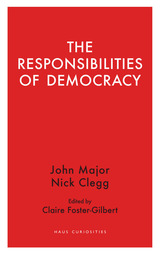
The Responsibilities of Democracy
Nick Clegg
Haus Publishing, 2019
Democracy operates on consent. That means politicians have an obligation to present and argue their causes in order to ultimately win consensus. Above all, democracy requires honesty—in facing up to challenges, acknowledging fears and dangers, and admitting the limitations of government. But democracy has its flaws, not least in the lack of efficiency in the decision-making process.
Amid pressing questions about the nature and limits of democracy, both in Britain and beyond, The Responsibilities of Democracy provides a clear-eyed perspective shared by two former politicians. Two central figures of the British political establishment, John Major and Nick Clegg, share their thoughts on where democracy is heading and how it can survive in the twenty-first century. Offering his perspective as a former prime minister, Major writes of the qualities on which a healthy democracy depends and expresses his deep concerns about the declining decorum of political exchange. Clegg brings a counter-perspective in discussing the ways in which political language has always involved trading insults and argues that echo chambers, although now more sophisticated, are nothing new. Compromise, Clegg insists, is not betrayal, but is instead the very substance of our politics and our democracy. The Responsibilities of Democracy explores the overall health of UK democracy, giving a balanced analysis of its values and flaws. It is also a clarion call to the electorate and politicians to nurture and protect the precious values on which democracy depends.
Amid pressing questions about the nature and limits of democracy, both in Britain and beyond, The Responsibilities of Democracy provides a clear-eyed perspective shared by two former politicians. Two central figures of the British political establishment, John Major and Nick Clegg, share their thoughts on where democracy is heading and how it can survive in the twenty-first century. Offering his perspective as a former prime minister, Major writes of the qualities on which a healthy democracy depends and expresses his deep concerns about the declining decorum of political exchange. Clegg brings a counter-perspective in discussing the ways in which political language has always involved trading insults and argues that echo chambers, although now more sophisticated, are nothing new. Compromise, Clegg insists, is not betrayal, but is instead the very substance of our politics and our democracy. The Responsibilities of Democracy explores the overall health of UK democracy, giving a balanced analysis of its values and flaws. It is also a clarion call to the electorate and politicians to nurture and protect the precious values on which democracy depends.
[more]
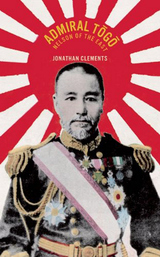
Admiral Togo
Nelson of the East
Jonathan Clements
Haus Publishing, 2010
Togo Heihachiro (1848-1934) was born into a feudal society that had lived in seclusion for 250 years. As a teenage samurai, he witnessed the destruction wrought upon his native land by British warships. As the legendary "Silent Admiral", he was at the forefront of innovations in warfare, pioneering the Japanese use of modern gunnery and wireless communication. He is best known as "the Nelson of the East" for his resounding victory over the Tsar's navy in the Russo-Japanese War, but he also lived a remarkable life: studying at a British maritime college, witnessing the Sino-French War, the Hawaiian Revolution, and the Boxer Uprising. After his retirement, he was appointed to oversee the education of the Emperor, Hirohito. This new biography spans Japan's sudden, violent leap out of its self-imposed isolation and into the 20th century. Delving beyond Togo's finest hour at the Battle of Tsushima, it portrays the life of a diffident Japanese sailor in Victorian Britain, his reluctant celebrity in America (where he was laid low by Boston cooking and welcomed by his biggest fan, Theodore Roosevelt), forgotten wars over the short-lived Republics of Ezo and Formosa, and the accumulation of peacetime experience that forged a wartime hero.
[more]

An Armchair Traveller's History of Beijing
Jonathan Clements
Haus Publishing, 2016
As China’s global influence continues to rise, its capital, Beijing, has become increasingly important—and a popular tourist destination, greeting close to five million international visitors each year. An Armchair Traveller’s History of Beijing presents the capital from its earliest beginnings as a prehistoric campsite for Peking Man through its fluctuating fortunes under a dozen dynasties.
Home to capitals of several states over time, the site of modern Beijing has been ruled by Mongolian chiefs and the glorious Ming emperors, whose tombs can still be found on its outskirts. Through Beijing, we can experience Chinese history itself, including its more famous residents—including Khubilai Khan, Mulan, and Marco Polo. Special emphasis is placed on Beijing’s precarious heritage in the twenty-first century, as modern construction wipes out much of the old city to make way for homes for twenty million people.
This book also offers detailed information on sites of tourist interest, including the pros and cons of different sections of the Great Wall and the best ways to see the Forbidden City and the fast-disappearing relics of the city’s Manchu and Maoist eras. A chapter on food and drink examines not only local delicacies, but the many other Chinese dishes that form part of Beijing’s rich dining traditions. With its blend of rich history and expert tips, An Armchair Traveller’s History of Beijing is an essential introduction to one of the world’s most remarkable cities.
Home to capitals of several states over time, the site of modern Beijing has been ruled by Mongolian chiefs and the glorious Ming emperors, whose tombs can still be found on its outskirts. Through Beijing, we can experience Chinese history itself, including its more famous residents—including Khubilai Khan, Mulan, and Marco Polo. Special emphasis is placed on Beijing’s precarious heritage in the twenty-first century, as modern construction wipes out much of the old city to make way for homes for twenty million people.
This book also offers detailed information on sites of tourist interest, including the pros and cons of different sections of the Great Wall and the best ways to see the Forbidden City and the fast-disappearing relics of the city’s Manchu and Maoist eras. A chapter on food and drink examines not only local delicacies, but the many other Chinese dishes that form part of Beijing’s rich dining traditions. With its blend of rich history and expert tips, An Armchair Traveller’s History of Beijing is an essential introduction to one of the world’s most remarkable cities.
[more]

An Armchair Traveller's History of Finland
Jonathan Clements
Haus Publishing, 2014
In the American mind, Finland is often swept up in the general group of Nordic countries, little known and seldom gaining prominence on its own. But as Jonathan Clements shows in An Armchair Traveller’s History of Finland, it has a long and fascinating history, one that offers oddities and excitements galore: from prehistoric herders to medieval lords, Christian martyrs and Viking kings, and the war heroes who held off the Soviet Union against long odds.
Clements travels the length of the country as he tells these stories, along the way offering accounts of Finland’s public artworks, literary giants, legends and folktales, and famous figures. The result is the perfect introduction to Finland for armchair and actual travelers alike.
Clements travels the length of the country as he tells these stories, along the way offering accounts of Finland’s public artworks, literary giants, legends and folktales, and famous figures. The result is the perfect introduction to Finland for armchair and actual travelers alike.
[more]

An Armchair Traveller's History of Tokyo
Jonathan Clements
Haus Publishing, 2018
With almost 13 million residents, Tokyo is now as much an icon of modernity as it is a city, with its neon-lit billboards, futuristic technology, and avant-garde fashion scene. But the long and fascinating history of Japan’s modern capital encompasses much, much more, and in An Armchair Traveller’s History of Tokyo, Jonathan Clements sketches the city’s amazing trajectory from its humble beginnings as a group of clearings in a forest on the Kanto plain all the way to its upcoming role as host of the 2020 Olympic Games.
Tokyo, meaning “Eastern Capital,” has only enjoyed that name and status for 150 years. Before that, it was a medieval outpost designed to keep watch over rich farmlands. But this seemingly unassuming geographical location ultimately led to its status as a supercity. Though the imperial court ruled Japan from the sleepy city of Kyoto, the landowners of the Kanto plain where Tokyo lies held the true wealth and power in Japan, which they eventually asserted in a series of bloody civil wars. The Tokyo region became the administrative center of Japan’s Shogun overlords and the site of a vibrant urban culture home to theaters, taverns, and brothels. After the Meiji Restoration in 1868, it became Japan’s true capital, home to the emperors, the seat of government, and a site of rapid urban growth.
Anyone who’s ever longed to look upon Mount Fuji, embody the bravery of the Samurai, or savor the world’s finest sushi will find themselves transported from the comfort of their armchair while reading Clements’s account of Tokyo.
Tokyo, meaning “Eastern Capital,” has only enjoyed that name and status for 150 years. Before that, it was a medieval outpost designed to keep watch over rich farmlands. But this seemingly unassuming geographical location ultimately led to its status as a supercity. Though the imperial court ruled Japan from the sleepy city of Kyoto, the landowners of the Kanto plain where Tokyo lies held the true wealth and power in Japan, which they eventually asserted in a series of bloody civil wars. The Tokyo region became the administrative center of Japan’s Shogun overlords and the site of a vibrant urban culture home to theaters, taverns, and brothels. After the Meiji Restoration in 1868, it became Japan’s true capital, home to the emperors, the seat of government, and a site of rapid urban growth.
Anyone who’s ever longed to look upon Mount Fuji, embody the bravery of the Samurai, or savor the world’s finest sushi will find themselves transported from the comfort of their armchair while reading Clements’s account of Tokyo.
[more]

A History of the Silk Road
Jonathan Clements
Haus Publishing, 2017
The Silk Road is not a place, but a journey, a route from the edges of the Mediterranean to the central plains of China, through high mountains and inhospitable deserts. For thousands of years its history has been a traveler’s history, of brief encounters in desert towns, snowbound passes and nameless forts. It was the conduit that first brought Buddhism, Christianity and Islam into China, and the site of much of the “Great Game” between 19th-century empires. Today, its central section encompasses several former Soviet republics, and the Chinese Autonomous Region of Xinjiang. The ancient trade route controversially crosses the sites of several forgotten kingdoms, buried in sand and only now revealing their secrets.
A History of the Silk Road not only offers the reader a chronological outline of the region’s development, but also provides an invaluable introduction to its languages, literature, and arts. It takes a comprehensive and illuminating look at the rich history of this dynamic and little known region, and provides an easy-to-use reference source. Jonathan Clements pays particular attention to the fascinating historical sites which feature on any visitor’s itinerary and also gives special emphasis to the writings and reactions of travelers through the centuries.
A History of the Silk Road not only offers the reader a chronological outline of the region’s development, but also provides an invaluable introduction to its languages, literature, and arts. It takes a comprehensive and illuminating look at the rich history of this dynamic and little known region, and provides an easy-to-use reference source. Jonathan Clements pays particular attention to the fascinating historical sites which feature on any visitor’s itinerary and also gives special emphasis to the writings and reactions of travelers through the centuries.
[more]
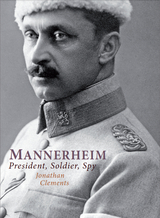
Mannerheim
President, Soldier, Spy
Jonathan Clements
Haus Publishing, 2012
Baron Gustaf Mannerheim was one of the greatest figures of the twentieth century, and the only man to be decorated by both sides in the Second World War. As a Finnish officer in Russian service, he witnessed the coronation of the last Tsar, and was both reprimanded for foolhardiness and decorated for bravery in the Russo-Japanese War. He spent two years undercover in Asia as an agent in the 'Great Game', posing as a Swedish anthropologist. He crossed China on horseback, stopping en route to teach the 13th Dalai Lama how to shoot with a pistol, and spying on the Japanese navy on his way home. He escaped the Bolsheviks by the skin of his teeth in 1917, arriving in the newly independent Finland just in time to lead the anti-Russian forces in the local revolt and civil war. During Finland's darkest hour, he lead the defence of his country against the impossible odds of the Winter War. This major new life of Gustaf Mannerheim, the first to be published for over a decade, includes new historical material on Mannerheim's time in China.
[more]

Marco Polo
Jonathan Clements
Haus Publishing, 2006
The records of the Chinese Yuan dynasty do not mention a Marco Polo at all (and they should), and there aer some suspicious omissions from Polo's text - no tea, no foot-binding, no mention of Chinese printing, or even of the Great Wall. Did Polo even go to China?
[more]

Prince Saionji
Japan
Jonathan Clements
Haus Publishing, 2010
Prince Saionji Kinmochi (1849-1940). The Japanese delegation at the Paris Peace Conference did not have the Japanese prime or foreign ministers with them as they had only just been elected and had plenty to do back home. The delegation was instead led by Prince Saionji, the dashing 'kingmaker' of early 20th-century Japanese politics whose life spanned the arrival of Commodore Perry and his 'black ships', the Japanese civil war, the Meiji Restoration, the Sino-Japanese War, the Russo-Japanese War, the First World War, the Paris Peace Conference and the Treaty of Versailles, and the rise of Japanese militarism. Unlike many of the conservatives of his day, Saionji was a man with experience of international diplomacy and admiration for European culture. Brought up in the days of the last Shogun, he became an active supporter of Japan's new ruling regime, after the Shogun was overthrown in a civil war, and a leading figure in the post-Restoration reform movement. In 1869 he founded the institution that would become the Ritsumeikan University - literally, 'The place to establish one's destiny'. He was sent to France for nine years to investigate Western technology and philosophy, and served for a decade as a Japanese ambassador in Europe. Returning to Japan, he served twice as Minister of Education and later became prime minister before resigning to become a revered elder statesman. Japan entered the First World War on the Allied side, seizing German possessions in China and the Pacific. In the closing days of the war, Japanese military forces participated in the Siberian Intervention - an American-led invasion of eastern Russia against Communist insurgents. At the Conference Saionji's presence was initially regarded by the Japanese as a sign that Japan had become a fully-fledged member of the international community and accepted on an equal footing with the Western Powers. His delegation introduced a controversial proposal to legally enshrine racial equality as one of the tenets of the League of Nations. The Japanese were also keen to grab colonies of their own, and went head-to-head with the Chinese delegation over the fate of the former German possession of Shandong. When Shandong was 'returned' not to China but to its Japanese occupiers, riots broke out in China. Despite Saionji's statesmanship and diplomacy, the Treaty of Versailles was regarded by many Japanese as a slap in the face. Saionji's influence weakened in his last years, while his party was dissolved and amalgamated with others.
[more]
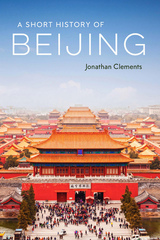
A Short History of Beijing
Jonathan Clements
Haus Publishing, 2022
A guide to the history of China’s capital, from before its rise to prominence as the seat of empires to the 2022 Winter Olympics.
Before China’s capital became a sprawling megacity and international center of business and culture, its fortunes fluctuated under a dozen dynasties. It has been a capital for several states, including those headed by Mongolian chiefs and the glorious Ming emperors, whose tombs can still be found on its outskirts. And before all that, it was a campsite for primitive hominids, known as the Peking Man. A Short History of Beijing tells the story of this remarkable city, from its more famous residents—Khubilai Khan, Marco Polo, and Chairman Mao—right up to the twenty-first century, as modern construction wiped out so much of the old city to make way for its twenty-million-strong population. Through his timely and intimate portrait of the world’s most populous capital city, Jonathan Clements reveals the history of China itself.
Before China’s capital became a sprawling megacity and international center of business and culture, its fortunes fluctuated under a dozen dynasties. It has been a capital for several states, including those headed by Mongolian chiefs and the glorious Ming emperors, whose tombs can still be found on its outskirts. And before all that, it was a campsite for primitive hominids, known as the Peking Man. A Short History of Beijing tells the story of this remarkable city, from its more famous residents—Khubilai Khan, Marco Polo, and Chairman Mao—right up to the twenty-first century, as modern construction wiped out so much of the old city to make way for its twenty-million-strong population. Through his timely and intimate portrait of the world’s most populous capital city, Jonathan Clements reveals the history of China itself.
[more]

A Short History of Finland
Jonathan Clements
Haus Publishing, 2022
A fascinating history of Finland from prehistoric times to the twenty-first century.
The modern nation of Finland is the heir to centuries of history, as a wilderness at the edge of early Europe, a borderland of the Swedish empire, and a Grand Duchy of tsarist Russia. And, as Jonathan Clements’s vivid, concise volume shows, it is a tale paved with oddities and excitements galore: from prehistoric reindeer herders to medieval barons, Christian martyrs to Viking queens, and, in the twentieth century, the war heroes who held off the Soviet Union against impossible odds.
Offering accounts of public artworks, literary giants, legends, folktales, and famous figures, Clements provides an indispensable portrait of this fascinating nation.
This updated edition includes expanded coverage on the Second World War, as well as new sections on Finns in America and Russia, the centenary of the republic, and Finland’s battle with COVID-19, right up to its historic application to join NATO.
The modern nation of Finland is the heir to centuries of history, as a wilderness at the edge of early Europe, a borderland of the Swedish empire, and a Grand Duchy of tsarist Russia. And, as Jonathan Clements’s vivid, concise volume shows, it is a tale paved with oddities and excitements galore: from prehistoric reindeer herders to medieval barons, Christian martyrs to Viking queens, and, in the twentieth century, the war heroes who held off the Soviet Union against impossible odds.
Offering accounts of public artworks, literary giants, legends, folktales, and famous figures, Clements provides an indispensable portrait of this fascinating nation.
This updated edition includes expanded coverage on the Second World War, as well as new sections on Finns in America and Russia, the centenary of the republic, and Finland’s battle with COVID-19, right up to its historic application to join NATO.
[more]

A Short History of Tokyo
Jonathan Clements
Haus Publishing, 2020
Tokyo, which in Japanese means the “Eastern Capital,” has only enjoyed that name and status for 150 years. Until the middle of the nineteenth century, the city that is now Tokyo was a sprawling fishing town by the bay named Edo. Earlier still, in the Middle Ages, it was Edojuku, an outpost overlooking farmlands. And thousands of years ago, its mudflats and marshes were home to elephants, deer, and marine life.
In this compact history, Jonathan Clements traces Tokyo’s fascinating story from the first forest clearances and the samurai wars to the hedonistic “floating world” of the last years of the Shogunate. He illuminates the Tokyo of the twentieth century with its destruction and redevelopment, boom and bust without forgoing the thousand years of history that have led to the Eastern Capital as we know it. Tokyo is so entwined with the history of Japan that it can be hard to separate them, and A Short History of Tokyo tells both the story of the city itself and offers insight into Tokyo’s position at the nexus of power and people that has made the city crucial to the events of the whole country.
In this compact history, Jonathan Clements traces Tokyo’s fascinating story from the first forest clearances and the samurai wars to the hedonistic “floating world” of the last years of the Shogunate. He illuminates the Tokyo of the twentieth century with its destruction and redevelopment, boom and bust without forgoing the thousand years of history that have led to the Eastern Capital as we know it. Tokyo is so entwined with the history of Japan that it can be hard to separate them, and A Short History of Tokyo tells both the story of the city itself and offers insight into Tokyo’s position at the nexus of power and people that has made the city crucial to the events of the whole country.
[more]
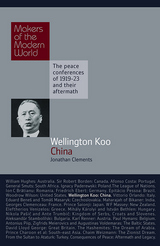
Wellington Koo
China
Jonathan Clements
Haus Publishing, 2010
Gu Weijun, a.k.a. Wellington Koo (1887-1985). Born in Shanghai and raised in the city's International Settlement, Koo became fluent in English during his postgraduate studies abroad - he got a PhD in Law from Columbia in 1912. He was recalled soon afterwards to become the English Secretary to the newly formed Republic of China, and became ambassador to the United States in 1915. He achieved notoriety at the Paris Peace Conference where he sternly resisted Japanese attempts to hold onto seized German colonial territory in mainland China. In protest at their treatment, the Chinese were the only delegates not to sign the subsequent Treaty of Versailles. Koo was China's first representative to the League of Nations, and ended up as acting president of Republican China during the unrest of the period 1926-7. He subsequently served briefly as a Foreign Minister during the peak of the Warlord Era, before returning to Europe, first as a delegate at the League of Nations, and then as China's ambassador to France. With the Nazi occupation, Koo fled to Britain, where he became the Chinese ambassador to the UK until 1946. A founder member of the United Nations, Koo was instrumental in maintaining the position of Republican China on the Security Council -by this time, 'Republican China' was limited solely to the island of Taiwan, while the Communists proclaimed themselves to be the new rulers of China itself. Retiring from the diplomatic service in 1956, the venerable Koo went on to become a judge at the International Court of Justice at the Hague, rising to vice-president before his retirement, aged 80, in 1967. He settled in New York, where his final years were tormented by 'Republican' China's loss of its seat on the United Nations Security Council to the Communists, following Nixon's famous visit to China.
[more]

The Flight Across The Ice
The Escape of the East Prussian Horses
Patricia Clough
Haus Publishing, 2010
The moving and untold story of the Russian advance into East Prussia in 1945, and the fight for survival of a people and their way of life
[more]

Umbria
The Heart of Italy
Patricia Clough
Haus Publishing, 2017
When Patricia Clough, a former foreign correspondent, bought a house in Umbria, she knew that buying her dream home did not mean that life would become a dream. By the end of this book, in which she describes the journey of making Umbria her home, she is sure that “if one has basic requirements for being happy, then Umbria provides some of the best surroundings for happiness.” Clough pores over Umbria's enchanting countryside, its tumultuous history, its ancient culture and sumptuous food, and laments that for a long time Umbria was mistaken for its fashionable neighbor, Tuscany. This is not a guide to buying a home in Italy, nor a guidebook for your holiday—though it would be useful as both of these things—but a story in which a woman discovers and marvels at the place she begins to call home.
[more]

Walking Pepys's London
Jacky Colliss Harvey
Haus Publishing, 2022
Brings to life the world of Samuel Pepys with five walks through London.
Samuel Pepys, the seventeenth century's best-known diarist, walked around London for miles, chronicling these walks in his diary. He made the two-and-a-half-mile trek to Whitehall from his house near the Tower of London on an almost daily basis. These streets, where many of his professional conversations took place while walking, became for him an alternative to his office.
With Walking Pepys’s London, we come to know life in London from the pavement up and see its streets from the perspective of this renowned diarist. The city was a key character in Pepys’s life, and this book draws parallels between his experience of seventeenth-century London and the lives of Londoners today. Bringing together geography, biography, and history, Jacky Colliss Harvey reconstructs the sensory and emotional experience of Pepys’s time. Full of fascinating details, Walking Pepys’s London is a sensitive exploration into the places that made the greatest English diarist of all time.
Samuel Pepys, the seventeenth century's best-known diarist, walked around London for miles, chronicling these walks in his diary. He made the two-and-a-half-mile trek to Whitehall from his house near the Tower of London on an almost daily basis. These streets, where many of his professional conversations took place while walking, became for him an alternative to his office.
With Walking Pepys’s London, we come to know life in London from the pavement up and see its streets from the perspective of this renowned diarist. The city was a key character in Pepys’s life, and this book draws parallels between his experience of seventeenth-century London and the lives of Londoners today. Bringing together geography, biography, and history, Jacky Colliss Harvey reconstructs the sensory and emotional experience of Pepys’s time. Full of fascinating details, Walking Pepys’s London is a sensitive exploration into the places that made the greatest English diarist of all time.
[more]
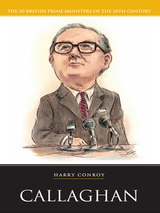
Callaghan
Harry Conroy
Haus Publishing, 2006
Part of the Prime Ministers Series, Callaghan was the Labour Prime Minister who was defeated by Thatcher
[more]

Aleksandur Stamboliiski
Bulgaria
Richard Crampton
Haus Publishing, 2009
Aleksandur Stamboliiski was one of the most original politicians of the 20th century. His tragedy was that he came to power at the end of the First World War in which Bulgaria had been defeated. It fell to him, therefore, to accept and apply the peace settlement. This created tensions between him and traditional Bulgarian nationalism, tensions which ended with his murder in 1923. The book will examine the origins of this traditional nationalism from the foundation of the Bulgarian state in 1878, and of the agrarian movement which came to represent the social aspirations of the majority of the peasant population. It will also illustrate Stamboliiski's rise to power and examine his ideology. Emphasis will be placed on how this ideology clashed with the monarchy, the military, and the nationalists. Stamboliiski's policies in the Balkan wars and the First World War will be described before the details of the 1919 peace settlement are examined. The implementation of those terms will then be discussed as will the coup of 1923. The legacy of the peace treaty in the inter-war period and of Stamboliiski's image in the years after his downfall will form the final section of the book.
[more]
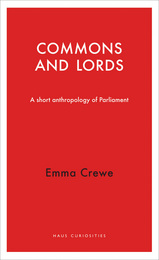
Commons and Lords
A Short Anthropology of Parliament
Emma Crewe
Haus Publishing, 2015
The British Parliament rewards close scrutiny not just for the sake of democracy, but also because the surprises it contains challenge our understanding of British politics. Commons and Lords pulls back the curtain on both the upper House of Lords and the lower House of Commons to examine their unexpected inner workings.
Based on fieldwork within both Houses, this volume in the Haus Curiosities series provides a surprising twist in how relationships in each play out. The high social status of peers in the House of Lords gives the impression of hierarchy and, more specifically, patriarchy. In contrast, the House of Commons conjures impressions of equality and fairness between members. But actual observation reveals the opposite: while the House of Lords has an egalitarian and cooperative ethos that is also supportive of female members, the competitive and aggressive House of Commons is a far less comfortable place for women. Offering many surprises and secrets, this book exposes the sheer oddity of the British parliament system.
Based on fieldwork within both Houses, this volume in the Haus Curiosities series provides a surprising twist in how relationships in each play out. The high social status of peers in the House of Lords gives the impression of hierarchy and, more specifically, patriarchy. In contrast, the House of Commons conjures impressions of equality and fairness between members. But actual observation reveals the opposite: while the House of Lords has an egalitarian and cooperative ethos that is also supportive of female members, the competitive and aggressive House of Commons is a far less comfortable place for women. Offering many surprises and secrets, this book exposes the sheer oddity of the British parliament system.
[more]

An Extraordinary Scandal
The Westminster Expenses Crisis and Why It Still Matters
Emma Crewe
Haus Publishing, 2019
A parliamentary scandal that dominates the headlines. The resignation of major party figures. Commentators and citizens wondering if the British government—and the people’s faith in it—will survive. Before Brexit, another major crisis rocked the foundation of government in the country: the expenses scandal of 2009.
Featuring interviews with the members of parliament, journalists, and officials close to the center of the turmoil, An Extraordinary Scandal tells the story of what really happened. Andrew Walker, the tax expert who oversaw the parliamentary expenses system, and Emma Crewe, a social scientist specializing in the institutions of parliament, bring fascinating perspectives—from both inside and outside parliament—to this account. Far from attempting provide a defense of any the parties involved, An Extraordinary Scandal explains how the parliament fell out of step with the electorate and became a victim of its own remote institutional logic, growing to become at odds with an increasingly open, meritocratic society.
Charting the crisis from its 1990s origins—when Westminster began, too slowly, to respond to wider societal changes—to its aftermath in 2010, the authors examine how the scandal aggravated the developing crisis of trust between the British electorate and Westminster politicians that continues to this day. Their in-depth research reveals new insight into how the expenses scandal acted as a glimpse of what was to come, and they reveal where the scandal’s legacy can be traced in the new age of mistrust and outrage, in which politicians are often unfairly vulnerable to being charged in the court of public opinion by those they represent.
Featuring interviews with the members of parliament, journalists, and officials close to the center of the turmoil, An Extraordinary Scandal tells the story of what really happened. Andrew Walker, the tax expert who oversaw the parliamentary expenses system, and Emma Crewe, a social scientist specializing in the institutions of parliament, bring fascinating perspectives—from both inside and outside parliament—to this account. Far from attempting provide a defense of any the parties involved, An Extraordinary Scandal explains how the parliament fell out of step with the electorate and became a victim of its own remote institutional logic, growing to become at odds with an increasingly open, meritocratic society.
Charting the crisis from its 1990s origins—when Westminster began, too slowly, to respond to wider societal changes—to its aftermath in 2010, the authors examine how the scandal aggravated the developing crisis of trust between the British electorate and Westminster politicians that continues to this day. Their in-depth research reveals new insight into how the expenses scandal acted as a glimpse of what was to come, and they reveal where the scandal’s legacy can be traced in the new age of mistrust and outrage, in which politicians are often unfairly vulnerable to being charged in the court of public opinion by those they represent.
[more]

Sybil Thorndike
A Star Of Life
Jonathan Croall
Haus Publishing, 2009
Outside the theatrical profession Sybil Thorndike is no longer the household name she once was; she has become a historical figure. Yet her combative, inspiring life, her passionate concern for the state of the world as well as for her art, resonates with any age. As the actor Michael Macliammóir put it: 'Essentially English, she is yet nationless; essentially of her period, she is yet timeless.'
[more]
READERS
Browse our collection.
PUBLISHERS
See BiblioVault's publisher services.
STUDENT SERVICES
Files for college accessibility offices.
UChicago Accessibility Resources
home | accessibility | search | about | contact us
BiblioVault ® 2001 - 2024
The University of Chicago Press









